Japan-Itaty Traditional and Contemporary Arts Exhibition
- 2010.05.26
- Activity

March 11th-12th
9:00 a.m.
A group of Japanese artists left Narita Airport and arrived at Rome Fiumicino Airport on March 11th. The following day, they headed to Siena, Toscana, touring world heritage sites in Rome along the way. While people associate Italian art with the Renaissance in Rome and Florence, the Siena Circle, the art circle originating in Siena, is said to have been the parallel jewel to the Florence Circle, whose members included Leonardo da Vinci and Michelangelo. As if to confront the naturalism pursued by the Florence Circle, the Siena Circle cultivated its own mode of expression taking the late Gothic style whose decorative and surrealistic palette constructs a remarkably mystic form.
Furthermore, the streets of Siena are reminiscent of the old Italian landscapes, where Greek and Byzantine style duomos and palaces built before the 16th century still stand, and retain remnants of the period. It is thus an ideal place to deepen exchanges between the Italian art scene and Japanese artists who are trained in traditional techniques and classic modes of expression.
March 13th
Magazzini del Sale, the venue for the exhibition, was located on the first and second basement levels of the Museo Civico del Comune di Siena. Situated in a good location near Piazza del Campo, the museum attracted many visitors from the opening day. Held at this site, known internationally as a famous tourist spot, the exhibition drew numerous students from both school trips and art universities, acting as a forum for international exchange.
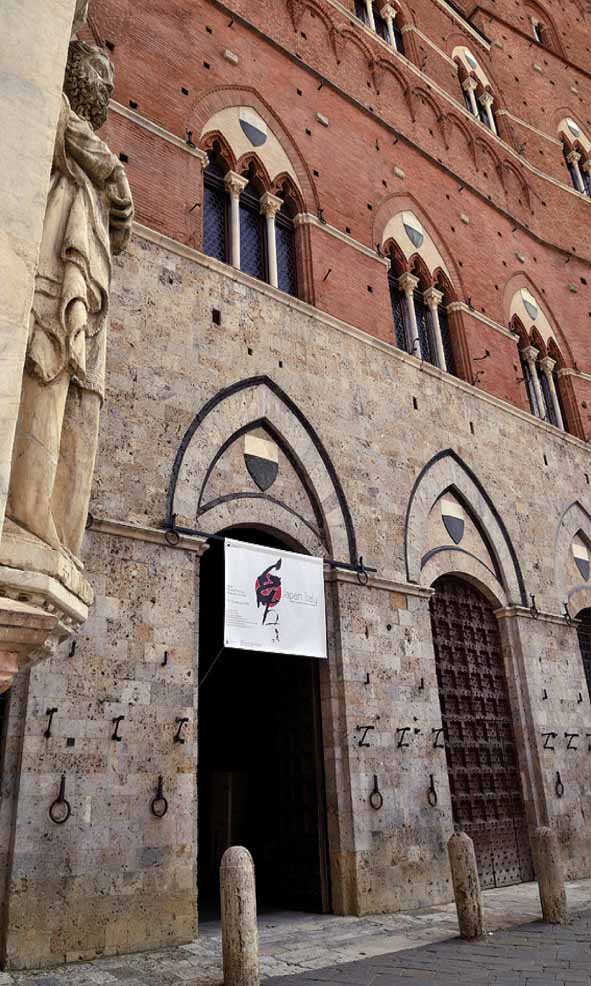 |
 |
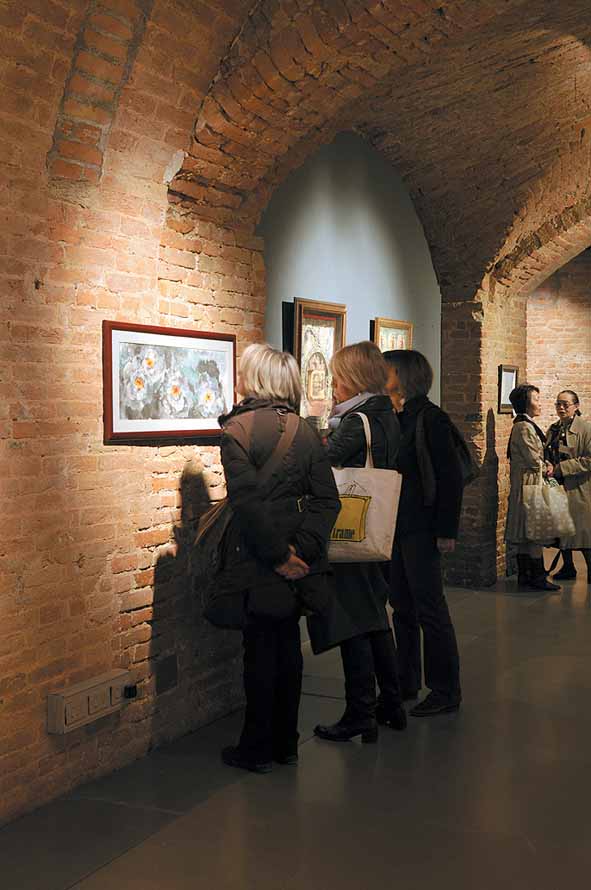 |
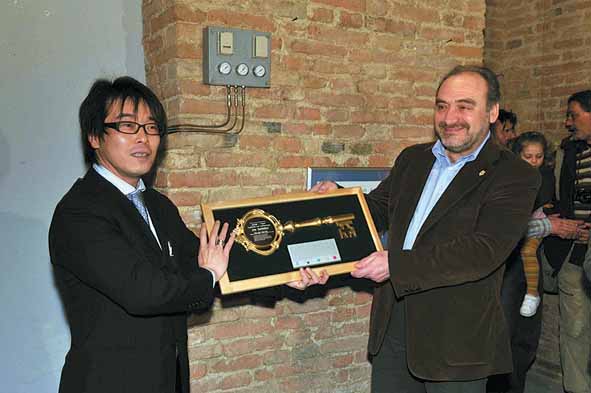

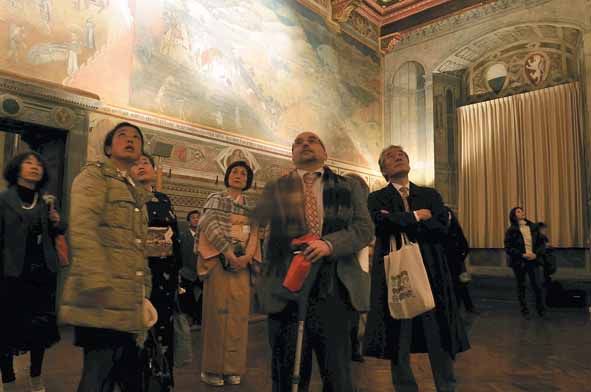
5:00 p.m.
In the evening, when the sky above Piazza del Campo was aglow with the setting sun, an opening ceremony for “Japan-Italy Traditional and Contemporary Art” exhibition was held at the venue inside of the Palazzo Pubblico. Representative figures of Siena’s art circles, such as Mauro Civai, the director of the Museo Civico del Comune di Siena, Piergiacomo Petrioli, professor of Università degli Studi di Firenze, and Michelina Simona Eremita, director of Museo d’Arte per Bambini di Siena, attended the ceremony. Opening themselves up to the bright and easygoing character of Italians, Japanese artists dressed in kimonos and formal suits gradually relaxed and engaged in friendly conversation. The scene of these artists smiling when they received a commemorative key to the city from Civai left quite an impression.
While many members of the media visited the exhibition site, what seized their attention the most was an outstanding live performance by the calligrapher Gyogetsu Akatsuka. Although performance art is becoming popular, Akatsuka’s work, with its elements of improvisation, must have looked fresh even to the eye of the Italian audience, the denizens of the city of arts, for it was different from other theatrical performance and traditional art. Being in the spotlight, Akatsuka wrote “beloved horse”, consisting of two Chinese characters “love”, the symbol of peace and exchange, and “horse”, the letter associated with Piazza del Campo (*There is a horse-chasing festival called Palio held biannually at the Piazza).
The reception ceremony was held on the verandas of the palace, which was followed by a courtesy call on the Museo Civico del Comune di Siena. Showcased in the museum were masterpieces by representative painters of the Siena Circle like Simone Martini’s fresco pieces “Maestà” and “Commemoration of Guidoriccio da Fogliano at the Siege of Montemassi”, and Ambrogio Lorenzetti’s “Allegory of Good Government: Effects of Good Government in the City” and “Allegory of Bad Government and Effects of Bad Government in the City and Countryside”. Unfortunately, Japanese audiences are largely not familiar with Sienese paintings, for most of them are large in size and hard to maintain in good condition, making them difficult to ship abroad. While listening to the commentary by Petrioli, who is also a curator of the museum, the Japanese artists couldn’t help but be struck by the magnificent scale of the Italian art before their eyes.
March 14th
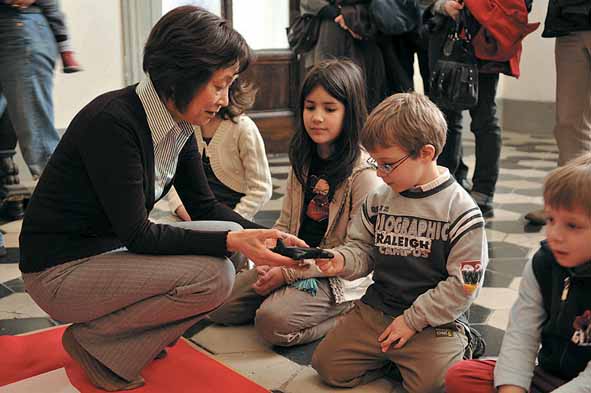
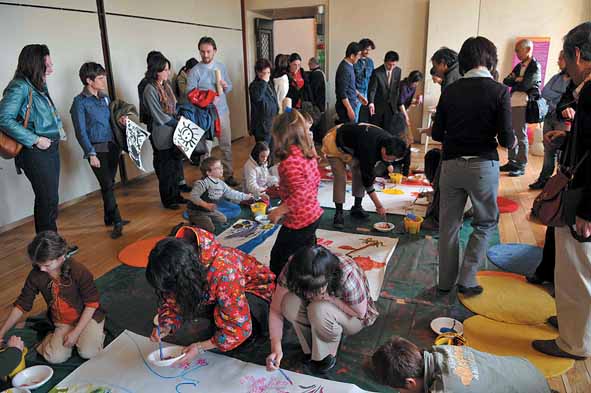
10:00 a.m.
A get-together between the Japanese artists and Sienese children was held at the Museo d’Arte per Bambini di Siena. Even though it was early in the morning, a lot of children and parents showed up and watched in awe at a calligraphy demonstration by Gyokuei Miyazawa. Considering the type of audience was different from the one at the ceremony held the day before, he deliberately wrote flowing kana characters. Then he went on to improvise the Chinese character “friend”. This work showed his tremendous awareness for his audience who might have seen Japanese words for the first time that day. After the performance, Miyazawa hosted an on-the-spot calligraphy class for the children. Taking the Chinese character “brightness” as its theme, he taught them about hieroglyphs, which could be easily learned by Italians who are not accustomed to Chinese characters, while also giving some tips on how to perform calligraphy. Moreover, origami was given out to the participants at the venue. As some Japanese artists showed how to make origami, the children observed the artists’ fingers with earnest eyes and tried their hand, following the experts’ examples.
Prepared next were large drawing sheets of paper, which would almost cover the entire floor of the venue. Following the theme of “spring”, a Japan-Italy collaborative piece was created. While there was no previous instruction or draft, children dipped their brushes in paint and immediately started swirling them about the paper. As if in response to such spontaneous activity by the children, the artists began to create their own pieces. The children astonished the artists by suddenly flinging paint from the tips of their brushes and spattering droplets onto the paper, proving their unexpected creativity.
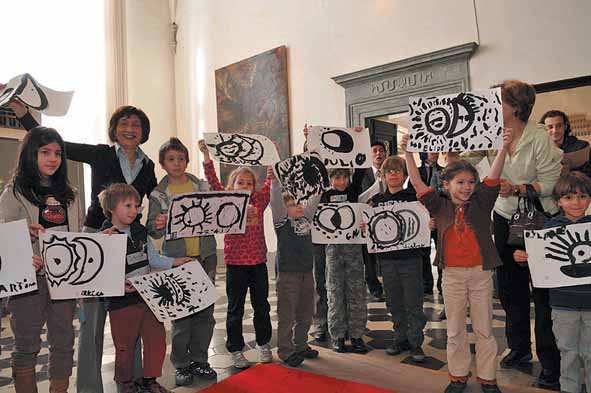 |
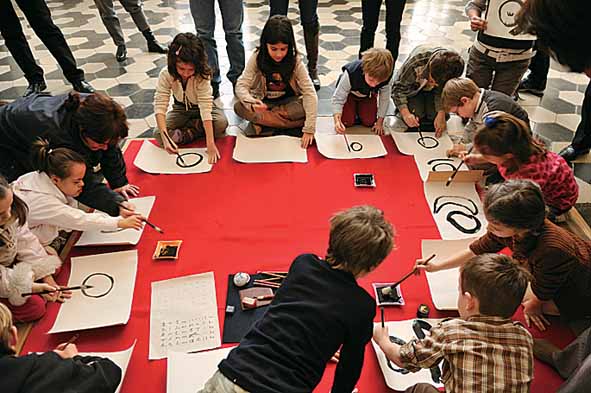 |
 |
1:00 p.m.
We toured the Historic Centre of San Gimignano, Siena, which is registered as a World Heritage Site. Standing in this small town situated on top of a hill at 324 meters elevation were a total of 72 towers of various sizes, the largest of which measuring 50 meters in height. While standing firmly on a cobblestone lane, I gave more than a passing thought to ancient times when this site would have bustled with activity.
March 15th
10:00 a.m.
We toured the streets of Florence where professor Petrioli teaches. At Galleria degli Uffizi, the oldest modern art museum, we learned about the heyday of the Renaissance as well as other art and cultural activities that gave birth to modern Italy. It was just breathtaking to see such an array of Italian masterpieces such as “Primavera”*1, “the Birth of Venus”*2 and “the Annunciation”*3. Moreover, by special permission, we were taken to “the Vasari Corridor” (Giorgio Vasari himself designed this feature, which now showcases a popular collection of portraits including his own. Reservation is required). Just as he did at the Museo Civico del Comune di Siena two days ago, professor Petrioli joined us once more and explained about the corridor and other features of Uffizi (his research theme is centered on Vasari and his book “the Lives of the Artists”). After that, we visited the Piazza della Signoria, which is located at the center of the city and faces the Cattedrale di Santa Maria del Fiore (duomo) and Palazzo Vecchio, as well as the Basilica di Santa Croce, known as “Glorious Pantheon of Italy”.
March 16th-17th
From Florence Airport to Narita Airport with a stop over at Fiumicino Airport in Rome.
Summary
Having been part of this first exhibition in Italy, which attracted widespread media attention, all the participants seemed to have felt confident that Japan and Italy have taken a significant step toward the realization of social education through the art of both nations. We have already received some requests to hold another exhibition in coming years. In the near future, art exchanges between Japan and Italy will only increase with growing stature.
*1 *2 Sandro Botticelli
*3 Leonardo da Vinci, Sandro Botticelli
| Sponsor: | WAC (World Art and Culture Exchange) |
| Support: | Comune di Siena Italia Japan Association UN NPO World Children’s Fund Museo dei Bambini Pascoli Elementary School |
Period: 11th-14th March 2009
Venue: Siena City Museum, Siena



